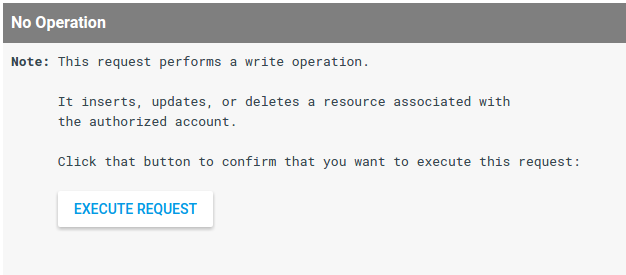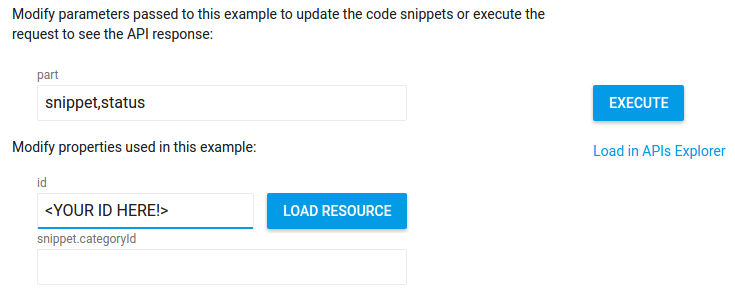操作说明
交互式代码段工具可让您轻松测试 API 请求,并生成特定于这些请求的代码示例。对于任何给定的方法,该工具会显示一个或多个用例的代码段,并且每个用例都会描述调用该方法的常用方法。例如,您可以调用 channels.list 方法来检索有关特定频道或当前用户频道的数据。
执行 API 请求
您可以点击请求参数列表旁边的执行按钮来执行请求。如果您之前没有授权应用程序代表您提交 API 请求,系统将提示您进行授权。作为一项额外的预防措施,如果您的请求执行了写入操作(插入、更新或删除与您的频道关联的资源),系统会要求您确认是否想要执行该请求,然后再实际执行。

切换代码段和完整示例
对于每个用例,该工具都会显示一个代码段,用于标识特定于所调用的特定方法的代码。每个代码段标识了所调用的方法,以及 API 请求中使用的参数和属性值。
此外,该工具还会显示完整的代码示例,该示例将代码段放入模板中,该模板定义了授权 API 请求和构建 API 请求所需的样板函数。您可以使用示例上方的滑块在代码段和完整示例之间切换:

在本地运行完整的代码示例
完整的代码示例可在本地复制和运行。请注意以下前提条件并设置运行完整代码示例的步骤:
<ph type="x-smartling-placeholder">前提条件
- Java 1.7 或更高版本
- Gradle 2.3 或更高版本
设置项目并运行代码示例
-
在 API 控制台中创建一个项目,并为 Web 应用设置凭据。根据需要设置已获授权的重定向 URI。
-
按照 API Java 快速入门指南中的说明准备您的项目,但要将默认
build.gradle文件的内容替换为以下代码:apply plugin: 'java' apply plugin: 'application' mainClassName = 'ApiExample' sourceCompatibility = 1.7 targetCompatibility = 1.7 version = '1.0' repositories { mavenCentral() } dependencies { compile 'com.google.api-client:google-api-client:1.22.0' compile 'com.google.oauth-client:google-oauth-client-jetty:1.22.0' compile 'com.google.apis:google-api-services-youtube:v3-rev182-1.22.0' compile group: 'com.google.code.gson', name: 'gson', version: '1.7.2' compile group: 'com.fasterxml.jackson.core', name: 'jackson-databind', version: '2.4.4' } compileJava { options.compilerArgs << "-Xlint:unchecked" << "-Xlint:deprecation" } -
在工作目录中,将与您的凭据关联的
client_secrets.json文件保存到src/main/resources/client_secret.json。 -
从您的工作目录中,将完整的代码示例复制到
src/main/java/ApiExample.java。(每个示例中的类名称均为ApiExample,因此您无需修改build.gradle文件即可运行不同的示例。) -
从命令行运行该示例:
gradle -q run
-
大多数示例会将某些内容输出到
STDOUT。您也可以访问 YouTube 网站,了解写入数据的请求(例如创建播放列表或频道版块的请求)的效果。
-
在 API 控制台中创建一个项目,并为 Web 应用设置凭据。设置已获授权的 JavaScript 来源,以确定您将从中发送请求的网址(例如
http://localhost)。 -
将完整的代码示例复制到您的 Web 服务器可访问的本地文件中(例如
/var/www/html/example.html)。 -
在代码示例中找到设置要用于请求的客户端 ID 的行,并将值替换为凭据的客户端 ID:
gapi.client.init({ 'clientId': 'REPLACE_ME', -
在浏览器中打开文件(例如
http://localhost/example.html)。建议使用带有调试控制台的浏览器,例如 Google Chrome。 -
根据需要为请求授权。如果请求获得授权,调试控制台应以 JSON 对象形式显示该请求的 API 响应。
前提条件
- 必须安装 Node.js。
- npm 软件包管理工具(随 Node.js 一起提供)。
- 适用于 Node.js 的 Google API 客户端库:
npm install googleapis --save
- 能够访问互联网和网络浏览器。
- Google 账号
设置项目并运行代码示例
-
在 API 控制台中创建项目,并在 Google API 控制台中设置 OAuth 2.0 凭据。设置凭据时,将应用类型设置为其他。
-
将与您的凭据关联的
client_secret.json文件保存到本地文件。 -
将完整的代码示例复制到
client_secret.json文件所在目录中的本地文件中(或修改示例以正确标识该文件的位置)。 -
从命令行运行该示例:
node sample.js
-
大多数示例会将内容输出到
STDOUT,对于 Web 应用示例,则会输出到您正在查看的网页。您也可以访问 YouTube 网站,了解写入数据的请求(例如创建播放列表或频道版块的请求)的效果。
前提条件
- Python 2.6 或更高版本
- pip 软件包管理工具
- 适用于 Python 的 Google API 客户端库:
pip install --upgrade google-api-python-client
- 用于用户授权的 google-auth、google-auth-oauthlib 和 google-auth-httplib2。
pip install --upgrade google-auth google-auth-oauthlib google-auth-httplib2
- Flask Python Web 应用框架(如果您要为 Web 服务器应用运行 Python 示例)。
pip install --upgrade flask
- 请求 HTTP 库。
pip install --upgrade requests
设置项目并运行代码示例
-
在 API 控制台中创建项目,并在 Google API 控制台中设置 OAuth 2.0 凭据。设置凭据时,对于使用 Flask Python Web 应用框架的示例,请将应用类型设置为 Web 应用,并为这些凭据设置已获授权的重定向 URI。否则,请将应用类型设置为其他。
-
将与您的凭据关联的
client_secret.json文件保存到本地文件。 -
将完整的代码示例复制到
client_secret.json文件所在目录中的本地文件中(或修改示例以正确标识该文件的位置)。 -
从命令行运行该示例:
python sample.py
网络服务器应用示例注意事项:
如果您要为网络服务器应用运行 Python 示例,则运行脚本会启动本地网络服务器。如需实际执行 API 请求,您需要在浏览器中转到提供的网页。例如,使用 Flask Web 应用框架的 Python 示例包含如下所示的一行代码:
app.run('localhost', 8080, debug=True)
此代码会在http://localhost:8080启动一个本地网络服务器。不过,在您在浏览器中实际导航到http://localhost:8080之前,脚本不会尝试执行 API 请求。(还必须将您的本地服务器的网址设置为授权凭据的授权重定向 URI。) -
大多数示例会将内容输出到
STDOUT,对于 Web 应用示例,则会输出到您正在查看的网页。您也可以访问 YouTube 网站,了解写入数据的请求(例如创建播放列表或频道版块的请求)的效果。
前提条件
- 安装了命令行界面 (CLI) 和 JSON 扩展程序的 PHP 5.4 或更高版本。
- Composer 依赖项管理工具。
- 适用于 PHP 的 Google API 客户端库:
php composer.phar require google/apiclient:^2.0
设置项目并运行代码示例
-
在 API 控制台中创建项目,并在 Google API 控制台中设置 OAuth 2.0 凭据。设置凭据时,将应用类型设置为其他。
-
将与您的凭据关联的
client_secret.json文件保存到本地文件。 -
将完整的代码示例复制到
client_secret.json文件所在目录中的本地文件中(或修改示例以正确标识该文件的位置)。 -
从命令行运行该示例:
php sample.php
-
大多数示例会将内容输出到
STDOUT,对于 Web 应用示例,则会输出到您正在查看的网页。您也可以访问 YouTube 网站,了解写入数据的请求(例如创建播放列表或频道版块的请求)的效果。
前提条件
- Ruby 2.0 或更高版本
- 适用于 Ruby 的 Google API 客户端库:
gem install google-api-client
设置项目并运行代码示例
-
在 API 控制台中创建项目,并在 Google API 控制台中设置 OAuth 2.0 凭据。设置凭据时,将应用类型设置为其他。
-
将与您的凭据关联的
client_secret.json文件保存到本地文件。 -
将完整的代码示例复制到
client_secret.json文件所在目录中的本地文件中(或修改示例以正确标识该文件的位置)。 -
从命令行运行该示例:
ruby sample.rb
-
大多数示例会将内容输出到
STDOUT,对于 Web 应用示例,则会输出到您正在查看的网页。您也可以访问 YouTube 网站,了解写入数据的请求(例如创建播放列表或频道版块的请求)的效果。
-
在 API 控制台中创建项目,并在 Google API 控制台中设置 OAuth 2.0 凭据。设置凭据时,将应用类型设置为其他。
-
将与您的凭据关联的
client_secret.json文件保存到本地文件。 -
将完整的代码示例复制到
client_secret.json文件所在目录中的本地文件中(或修改示例以正确标识该文件的位置)。 -
从命令行运行该示例:
go run sample.go
-
大多数示例会将内容输出到
STDOUT,对于 Web 应用示例,则会输出到您正在查看的网页。您也可以访问 YouTube 网站,了解写入数据的请求(例如创建播放列表或频道版块的请求)的效果。
使用样板函数
如上所述,完整的代码示例均使用样板代码来授权和构建 API 请求。例如,Python 示例中的 build_resource 函数使用将资源属性映射到其值的字典,以构建可插入或更新的资源。为 JavaScript、PHP、Ruby、Go 和 Apps Script 提供了类似的函数。
例如,以下标签页显示了如何调用用于构建资源的样板函数来构建 playlist 资源。请注意,样板函数不需要知道正在创建哪种类型的资源。
function createResource(properties) {
var resource = {};
var normalizedProps = properties;
for (var p in properties) {
var value = properties[p];
if (p && p.substr(-2, 2) == '[]') {
var adjustedName = p.replace('[]', '');
if (value) {
normalizedProps[adjustedName] = value.split(',');
}
delete normalizedProps[p];
}
}
for (var p in normalizedProps) {
// Leave properties that don't have values out of inserted resource.
if (normalizedProps.hasOwnProperty(p) && normalizedProps[p]) {
var propArray = p.split('.');
var ref = resource;
for (var pa = 0; pa < propArray.length; pa++) {
var key = propArray[pa];
if (pa == propArray.length - 1) {
ref[key] = normalizedProps[p];
} else {
ref = ref[key] = ref[key] || {};
}
}
};
}
return resource;
}
var resource = createResource({
'snippet.title': 'Sample playlist ',
'snippet.description': 'This is a sample playlist description.',
'snippet.tags[]': 'JavaScript code, interactive',
'snippet.defaultLanguage': '',
'status.privacyStatus': 'private'
}
# Build a resource based on a list of properties given as key-value pairs.
# Leave properties with empty values out of the inserted resource.
def build_resource(properties):
resource = {}
for p in properties:
# Given a key like "snippet.title", split into "snippet" and "title", where
# "snippet" will be an object and "title" will be a property in that object.
prop_array = p.split('.')
ref = resource
for pa in range(0, len(prop_array)):
is_array = False
key = prop_array[pa]
# Convert a name like "snippet.tags[]" to snippet.tags, but handle
# the value as an array.
if key[-2:] == '[]':
key = key[0:len(key)-2:]
is_array = True
if pa == (len(prop_array) - 1):
# Leave properties without values out of inserted resource.
if properties[p]:
if is_array:
ref[key] = properties[p].split(',')
else:
ref[key] = properties[p]
elif key not in ref:
# For example, the property is "snippet.title", but the resource does
# not yet have a "snippet" object. Create the snippet object here.
# Setting "ref = ref[key]" means that in the next time through the
# "for pa in range ..." loop, we will be setting a property in the
# resource's "snippet" object.
ref[key] = {}
ref = ref[key]
else:
# For example, the property is "snippet.description", and the resource
# already has a "snippet" object.
ref = ref[key]
return resource
resource = build_resource({
'snippet.title': 'Sample playlist ',
'snippet.description': 'This is a sample playlist description.',
'snippet.tags[]': 'Python code, interactive',
'snippet.defaultLanguage': '',
'status.privacyStatus': 'private'}
// Add a property to the resource.
function addPropertyToResource(&$ref, $property, $value) {
$keys = explode(".", $property);
$is_array = false;
foreach ($keys as $key) {
// Convert a name like "snippet.tags[]" to "snippet.tags" and
// set a boolean variable to handle the value like an array.
if (substr($key, -2) == "[]") {
$key = substr($key, 0, -2);
$is_array = true;
}
$ref = &$ref[$key];
}
// Set the property value. Make sure array values are handled properly.
if ($is_array && $value) {
$ref = $value;
$ref = explode(",", $value);
} elseif ($is_array) {
$ref = array();
} else {
$ref = $value;
}
}
// Build a resource based on a list of properties given as key-value pairs.
function createResource($properties) {
$resource = array();
foreach ($properties as $prop => $value) {
if ($value) {
addPropertyToResource($resource, $prop, $value);
}
}
return $resource;
}
$propertyObject = createResource(array(
'snippet.title' => 'Sample playlist ',
'snippet.description' => 'This is a sample playlist description.',
'snippet.tags[]' => 'Python code, interactive',
'snippet.defaultLanguage' => '',
'status.privacyStatus' => 'private'));
# Build a resource based on a list of properties given as key-value pairs.
def create_resource(properties)
resource = {}
properties.each do |prop, value|
ref = resource
prop_array = prop.to_s.split(".")
for p in 0..(prop_array.size - 1)
is_array = false
key = prop_array[p]
if key[-2,2] == "[]"
key = key[0...-2]
is_array = true
end
if p == (prop_array.size - 1)
if is_array
if value == ""
ref[key.to_sym] = []
else
ref[key.to_sym] = value.split(",")
end
elsif value != ""
ref[key.to_sym] = value
end
elsif ref.include?(key.to_sym)
ref = ref[key.to_sym]
else
ref[key.to_sym] = {}
ref = ref[key.to_sym]
end
end
end
return resource
end
resource = create_resource({
'snippet.title': 'Sample playlist ',
'snippet.description': 'This is a sample playlist description.',
'snippet.tags[]': 'Ruby code, interactive',
'snippet.default_language': '',
'status.privacy_status': 'private'})
// Build an object from an object containing properties as key-value pairs
function createResource(properties) {
var res = {};
var normalizedProps = {};
for (var p in properties) {
var value = properties[p];
if (p.substr(-2, 2) == '[]' && value) {
var adjustedName = p.replace('[]', '');
normalizedProps[adjustedName] = value.split(',');
} else {
normalizedProps[p] = value;
}
}
for (var p in normalizedProps) {
if (normalizedProps.hasOwnProperty(p) && normalizedProps[p]) {
var propArray = p.split('.');
var ref = res;
for (var pa = 0; pa < propArray.length; pa++) {
var key = propArray[pa];
if (pa == propArray.length - 1) {
ref[key] = normalizedProps[p];
} else {
ref = ref[key] = ref[key] || {};
}
}
};
}
return res;
}
var resource = createResource({
'snippet.title': 'Sample playlist ',
'snippet.description': 'This is a sample playlist description.',
'snippet.tags[]': 'Apps Script code, interactive',
'snippet.defaultLanguage': '',
'status.privacyStatus': 'private'
});
func addPropertyToResource(ref map[string]interface{}, keys []string, value string, count int) map[string]interface{} {
for k := count; k < (len(keys) - 1); k++ {
switch val := ref[keys[k]].(type) {
case map[string]interface{}:
ref[keys[k]] = addPropertyToResource(val, keys, value, (k + 1))
case nil:
next := make(map[string]interface{})
ref[keys[k]] = addPropertyToResource(next, keys, value, (k + 1))
}
}
// Only include properties that have values.
if (count == len(keys) - 1 && value != "") {
valueKey := keys[len(keys)-1]
if valueKey[len(valueKey)-2:] == "[]" {
ref[valueKey[0:len(valueKey)-2]] = strings.Split(value, ",")
} else if len(valueKey) > 4 && valueKey[len(valueKey)-4:] == "|int" {
ref[valueKey[0:len(valueKey)-4]], _ = strconv.Atoi(value)
} else if value == "true" {
ref[valueKey] = true
} else if value == "false" {
ref[valueKey] = false
} else {
ref[valueKey] = value
}
}
return ref
}
func createResource(properties map[string]string) string {
resource := make(map[string]interface{})
for key, value := range properties {
keys := strings.Split(key, ".")
ref := addPropertyToResource(resource, keys, value, 0)
resource = ref
}
propJson, err := json.Marshal(resource)
if err != nil {
log.Fatal("cannot encode to JSON ", err)
}
return string(propJson)
}
func main() {
properties := (map[string]string{
"snippet.title": "Sample playlist ",
"snippet.description": "This is a sample playlist description.",
"snippet.tags[]": "Go code, interactive",
"snippet.defaultLanguage": "",
"status.privacyStatus": "private",
})
res := createResource(properties)加载现有资源
要测试更新现有资源的请求,您可以将该资源的当前属性值加载到更新表单中。例如,如需更新某个视频的元数据,请在 id 属性字段中输入视频 ID,然后点击 Load resource 按钮。当前属性值会加载到表单中,您可以只更新要更改的值。

